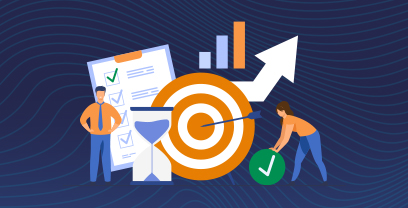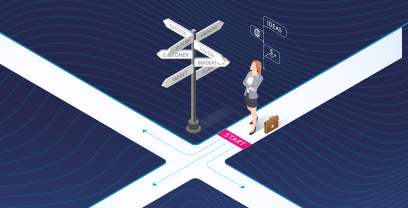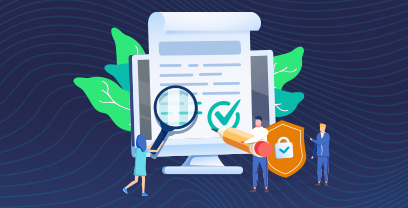In this post, we’ll delve into eSourcing, including what it is, why it matters and key benefits to procurement organizations. Then we’ll look at a real-world example and provide some best practices for choosing an eSourcing solution.
What is eSourcing?
Managing complex supplier relationships, ensuring cost-effectiveness, and maintaining compliance with regulations – are all key responsibilities of procurement. To date, much of the sourcing process has been manual, putting stress on already overworked procurement teams, and leading to errors, inefficiencies, and missed cost optimization opportunities.
eSourcing is a digital procurement process that enables buyers to manage the sourcing of goods and services using a web-based sourcing platform. This technology helps automate various procurement activities such as supplier evaluation, bidding and contract negotiation to improve decision-making, optimize supplier selection and foster competitive bidding.
eSourcing streamlines both the sourcing and procurement processes, making it more efficient and cost-effective. It enhances spend visibility and speeds up procurement cycles by allowing buyers and suppliers to interact and transact efficiently online through eAuctions.
Comparison: eSourcing vs. eProcurement
eSourcing and eProcurement are both digital approaches in the procurement process but serve different functions.
eSourcing focuses on the early stages of the procurement process, such as finding and evaluating supplier proposals, and awarding business. eProcurement, on the other hand, encompasses the entire transactional procurement process, including purchase requisition and order creation and processing, and invoice creation, processing, and payment. It automates and manages the transactional aspects of purchasing goods and services, using digital catalogs, electronic purchase orders and online payment systems.
The objective of eSourcing software is to identify the best suppliers, proposals, and negotiate favorable terms, while eProcurement aims to leverage the results of the eSourcing process, and then streamline and automate the transactional buying process. eSourcing plays a pivotal role in determining strategic sourcing decisions and supplier relationships, while eProcurement drives operational efficiency throughout the procurement cycle.
What Are The Steps in The eSourcing Process?
The eSourcing process typically involves several steps:
- Opportunity Identification: Identification of a new business need, or existing spend where supplier aggregation, or other strategic opportunities may exist
- Project Planning: Define the scope, timeline, and goals of the sourcing project.
- Research & Market analysis: Research potential suppliers, market conditions, and drivers.
- RFI/RFP/RFQ/eAuction Creation & Management: Develop and issue Request for Information, Request for Proposals (RFPs) or Request for Quotations (RFQs) to gather information from suppliers and proposals, and bids from suppliers. Conduct an online auction, if appropriate.
- Supplier evaluation: Assess and compare supplier bids based on predefined criteria.
- Negotiation & Award: Engage in negotiations with shortlisted suppliers for better terms, award business to selected supplier(s).
- Contracting: Negotiate contract terms and execute agreements with the chosen supplier.
*Integration: Integrate sourcing & CLM solution with procurement systems and processes, to enable a seamless flow of data to power the transactional procurement process.
How eSourcing Complements Broader Procurement Strategies
In 2024, most procurement leaders – 53% according to a recent Amazon Business study – will be increasing spending and investing in new technologies, in hopes of improving efficiency and generating value. Having saved funds in 2023, they now have wiggle room to invest in ways to optimize procurement processes, such as eSourcing.
eSourcing complements broader procurement strategies by enhancing supplier selection and negotiation, which are crucial for effective procurement. It provides a platform for competitive bidding and better analysis, leading to more informed decisions.
eSourcing also fosters stronger supplier relationships and better contract terms, contributing to overall procurement efficiency and cost-effectiveness. By integrating with Contract Lifecycle Management (CLM) and procurement systems, eSourcing ensures a seamless process and data flow from supplier selection to purchase and payment.
How to Find, Evaluate, and Select Suppliers Through
eSourcing platforms are a search tool that helps you locate suppliers and that specializes in the products or services you require, and use built-in filters to narrow down options based on location, industry, certifications, and more.
Once you have a list of potential suppliers, evaluate them based on their profile information. Look at their business history, customer reviews, ratings, and any available case studies or testimonials. Pay close attention to their response rate and communication effectiveness. Reach out to these suppliers to request more detailed information, such as product catalogs, pricing structures, minimum order quantities and lead times.
If the platform allows, submit a RFP or RFQ to gather structured responses from suppliers. Next, compare the responses you receive and assess them based on price, quality of products or services, compliance with standards, supply chain reliability and any value-added services offered. You can use a scoring system or matrix to objectively evaluate each supplier. Consider factors like total cost of ownership, reliability and alignment with your company’s values and needs.
After you’ve selected your suppliers, you must negotiate contract terms, including prices, delivery schedules and after-sales service, and formalize the agreement through a contract.
Much of this can be automated with the eSourcing platform. Use the platform’s tools for ongoing collaboration and communication – placing orders, tracking shipments, managing invoices and handling any issues or disputes.Throughout this process, you can take advantage of the platform’s messaging systems, documentation features and tracking tools to streamline communication and transaction management.
Remember, building a good relationship with suppliers is key to long-term success in procurement.
Key Advantages of an eSourcing Strategy
An eSourcing strategy can help benefit your organization:
- Streamline and simplify strategic sourcing activities: eSourcing streamlines and simplifies strategic sourcing activities by automating key processes like supplier research, bid collection and proposal evaluation. It provides a centralized platform for managing these activities, enhancing efficiency and reducing manual tasks.
- Implement best practices: Through automation, eSourcing software ensures the consistent application of procurement best practices, standardizing tasks like RFP creation and bid analysis and helping companies comply with industry standards and regulations.
- Improve spend management: eSourcing offers a centralized, transparent view of procurement activities for better tracking and control. What’s more, built-in analytics and reporting tools provide deeper insights into spending patterns and supplier performance, helping teams to optimize spending and resource allocation.
- Reduce risk: eSourcing reduces risk by enabling thorough supplier vetting and enhancing contract management, ensuring compliance and supply chain stability.
- Enhance supplier collaboration and relationship management: With a centralized platform for communication, teams benefit from transparent and efficient interactions with suppliers. It’s easier to share documents and information and supports innovation by encouraging collaboration.
To fully leverage all of these advantages, it’s critical to choose the right eSourcing software for your organization. Let’s explore how Dole was able to track all spend and achieve 12% savings in one year with Ivalua’s eSourcing software.
Dole eSourcing Case Study
Dole Food Company, a leading producer and marketer of fresh fruit and vegetables, was interested in driving sustainability and innovation with improved supplier capabilities and management. The company was also looking to rationalize the supply base and institute global supplier performance management.
However, because of decentralized and siloed procurement organizations across sites and business units, the procurement team had limited visibility, and 80% of spend was single-sourced. Not only that, a lack of effective category sourcing strategies was resulting in noncompliance and lost opportunities to reduce spend.
After implementing Ivalua, Dole successfully addressed direct spend, increased visibility, and was able to improve reporting and analytics for senior management. With a single platform for the entire organization, the procurement team not only improved compliance, but also streamlined the contracting process with standardized contract templates and approval workflows.
As a result, Dole realized a 10X ROI just on direct spend, with a 12% savings in one year. Read the full Dole eSourcing case study.
How To Enhance Your Sourcing Processes With eSourcing Tools
When implementing an eSourcing strategy, it’s important to look for eSourcing software that offers the following tools and features:
- Supplier Management Tools: These tools help organize and assess supplier data, allowing teams to track supplier performance, certifications and compliance.
- RFI/RFP/RFQ Management: Teams can create, distribute and manage RFIs, RFPs, and RFQs more efficiently, and handle bids in a fair, organized manner.
- Bid Comparison and Analysis: Tools (e.g., sourcing optimization) for comparing bids facilitate objective evaluation based on criteria like price, quality, and delivery times. They help identify the most competitive and suitable offers to help teams make data-driven decisions.
- Contract Management: eSourcing tools that offer contract management offer a centralized view of all contractual obligations. They assist in tracking and managing contracts, ensuring compliance with terms, monitoring expiration dates and managing renewals.
- Communication Tools: Efficient communication tools are essential for clear interaction with suppliers. Look for tools with features such as messaging and document sharing to support collaboration and transparency throughout the eSourcing process.
When Evaluating eSourcing Solutions, Be Sure To Ask The Following Vendor Questions:
- How well can the software integrate with our existing systems?
- What measures are in place for data security and regulatory compliance?
- Can the software be customized to meet our specific needs?
- What kind of customer support and training services do you offer?
- Can the solution scale up to accommodate our future growth?
- What is the total cost of ownership, including any hidden fees?
- How user-friendly is the software interface?
- What reporting and analytics capabilities does the software provide?
- Can you provide success stories or case studies relevant to our industry?
Achieve 360-Degree Visibility of Your Spend
eSourcing software will play a critical role for Procurement teams in 2024, helping teams streamline supplier selection and negotiations, automate sourcing activities, and strengthen supplier relationships. But choosing the right tool is crucial to generate value and boost profitability.
Ivalua offers a comprehensive and integrated Sourcing Platform designed to increase efficiency during the sourcing process. This includes a robust eSourcing solution that provides buyers with 360-degree dashboard views of their sourcing strategies, including supplier management, RFP/RFQ management, bid analysis and contract management – all through a user-friendly interface.
Learn how Ivalua’s S2C solution can enhance collaboration and transparency in supplier relationships, contributing to more strategic and effective procurement decisions.




